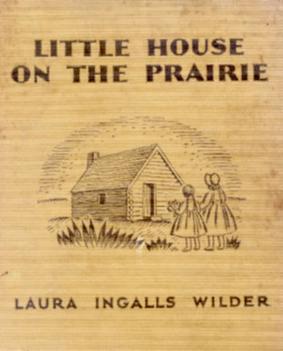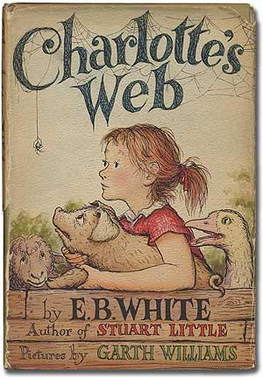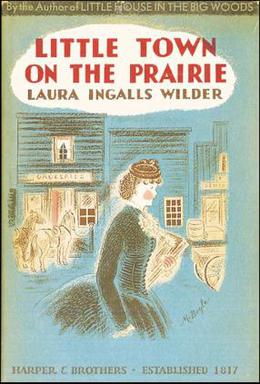
The Little House on the Prairie books comprise a series of American children's novels written by Laura Ingalls Wilder. The stories are based on her childhood and adolescence in the American Midwest between 1870 and 1894. Eight of the novels were completed by Wilder, and published by Harper & Brothers in the 1930s and 1940s, during her lifetime. The name "Little House" appears in the first and third novels in the series, while the third is identically titled Little House on the Prairie. The second novel, meanwhile, was about her husband's childhood.

Laura Elizabeth Ingalls Wilder was an American writer. The Little House on the Prairie series of children's books, published between 1932 and 1943, were based on her childhood in a settler and pioneer family.

Charlotte's Web is a book of children's literature by American author E. B. White and illustrated by Garth Williams; it was published on October 15, 1952, by Harper & Brothers. The novel tells the story of a livestock pig named Wilbur and his friendship with a barn spider named Charlotte. When Wilbur is in danger of being slaughtered by the farmer, Charlotte writes messages in her web praising Wilbur, such as "Some Pig" and "Humble", to persuade the farmer to let him live.

Almanzo James Wilder was the husband of Laura Ingalls Wilder and the father of Rose Wilder Lane, both noted authors.

Caroline Lake Ingalls (; née Quiner (later Holbrook); December 12, 1839 – April 20, 1924) was an American schoolteacher who was the mother of Laura Ingalls Wilder, author of the Little House books.

Charles Phillip Ingalls was an American pioneer, farmer, government official, musician, and carpenter who was the father of Laura Ingalls Wilder, known for her Little House series of books. He is depicted as the character "Pa" in the books and the television series.
Laura Ingalls Wilder's Little House on the Prairie is a 2005 American western television miniseries directed by David L. Cunningham. It is a six-part adaptation of children's novels Little House in the Big Woods (1932) and Little House on the Prairie (1935) by Laura Ingalls Wilder. It was broadcast on ABC as part of The Wonderful World of Disney anthology series.
Nellie Oleson is a fictional character in the Little House series of autobiographical children's novels written by Laura Ingalls Wilder. She was portrayed by Alison Arngrim in the NBC television show Little House on the Prairie, where her role is much expanded. Three different girls from Laura Ingalls Wilder's childhood — Nellie Owens, Genevieve Masters and Stella Gilbert — were the basis for the fictional Nellie Oleson.

The Long Winter is an autobiographical children's novel written by Laura Ingalls Wilder and published in 1940, the sixth of nine books in her Little House series. It is set in southeastern Dakota Territory during the severe winter of 1880–1881, when she turned 14 years old.

The First Four Years is an autobiographical novel by Laura Ingalls Wilder, published in 1971 and commonly considered the last of nine books in the Little House series. The series had initially concluded at eight children's novels following Wilder to mature age and her marriage with Almanzo Wilder.

On the Banks of Plum Creek is an autobiographical children's novel written by Laura Ingalls Wilder and published in 1937, the fourth of nine books in her Little House series. It is based on a few years of her childhood when the Ingalls family lived at Plum Creek near Walnut Grove, Minnesota, during the 1870s. The original dust jacket proclaimed, "The true story of an American pioneer family by the author of Little House in the Big Woods".

By the Shores of Silver Lake is an autobiographical children's novel written by Laura Ingalls Wilder and published in 1939, the fifth of nine books in her Little House series. It spans just over one year, beginning when she is 12 years old and her family moves from Plum Creek, Minnesota to what will become De Smet, South Dakota.

Little Town on the Prairie is an autobiographical children's novel written by Laura Ingalls Wilder and published in 1941, the seventh of nine books in her Little House series. It is set in De Smet, South Dakota. It opens in the spring after the Long Winter and ends as Laura becomes a school teacher so she can help her sister, Mary, stay at a school for the blind in Vinton, Iowa. It tells the story of 15-year-old Laura's first paid job outside of home and her last term of schooling. At the end of the novel, she receives a teacher's certificate and is employed to teach at the Brewster settlement, 12 miles (19 km) away.

These Happy Golden Years is an autobiographical children's novel written by Laura Ingalls Wilder and published in 1943, the eighth of nine books in her Little House series – although it originally ended it. It is based on her later adolescence near De Smet, South Dakota, featuring her short time as a teacher, beginning at age 15, and her courtship with Almanzo Wilder. It spans the time period from 1882 to 1885, when they marry.

Farmer Boy is a children's historical novel written by Laura Ingalls Wilder and published in 1933. It was the second-published one in the Little House series but it is not related to the first, which that of the third directly continues. Thus the later Little House on the Prairie is sometimes called the second one in the series, or the second volume of "the Laura Years".
Helen Sewell was an American illustrator and writer of children's books. She won a Caldecott Medal Honor as illustrator of The Thanksgiving Story by Alice Dalgliesh and she illustrated several novels that were runners-up for the Newbery Medal.

Little House on the Prairie is an autobiographical children's novel by Laura Ingalls Wilder, published in 1935. It was the third novel published in the Little House series, continuing the story of the first, Little House in the Big Woods (1932), but not related to the second. Thus, it is sometimes called the second one in the series, or the second volume of "the Laura Years".

Let the Hurricane Roar, reissued as Young Pioneers starting from 1976, is a short novel by Rose Wilder Lane that incorporates elements of the childhood of her mother Laura Ingalls Wilder. It was published in The Saturday Evening Post as a serial in 1932 and by Longmans as a book early in 1933, not long after Little House in the Big Woods (1932), the first volume of her mother's Little House series.
William Anderson is an American author, historian, and lecturer. He is a specialist in the subject of Laura Ingalls Wilder and her times.
















